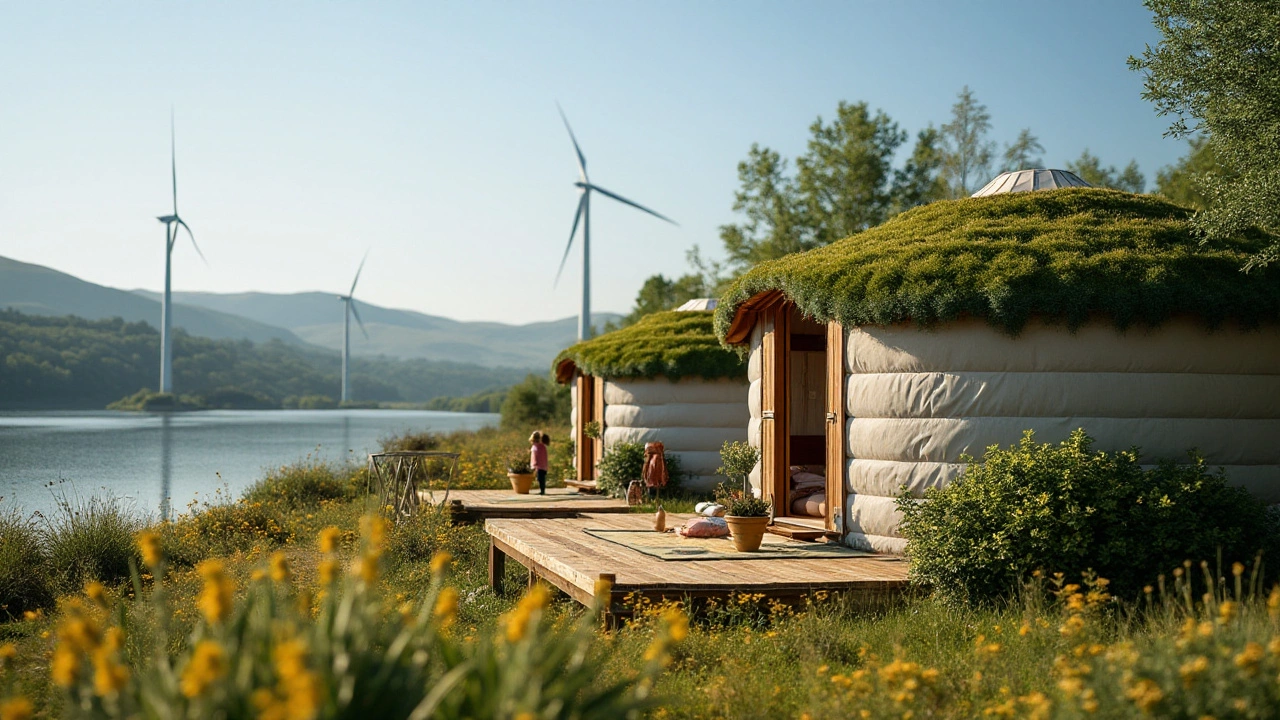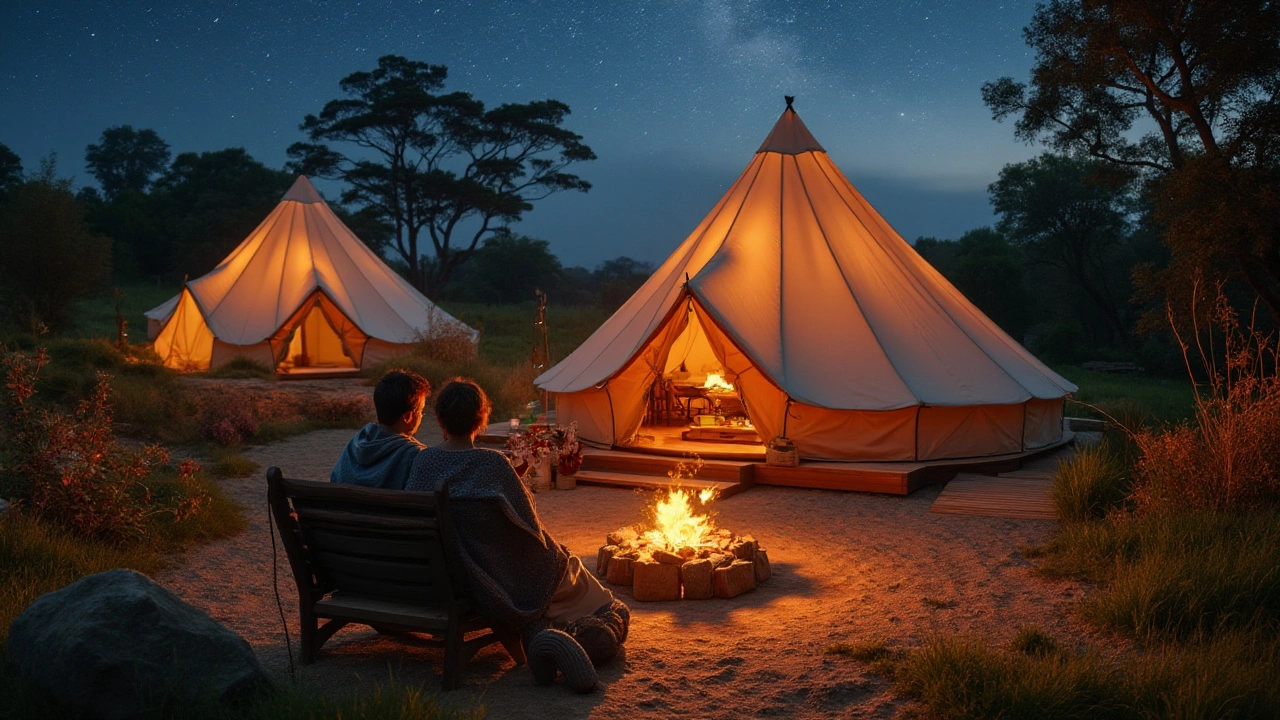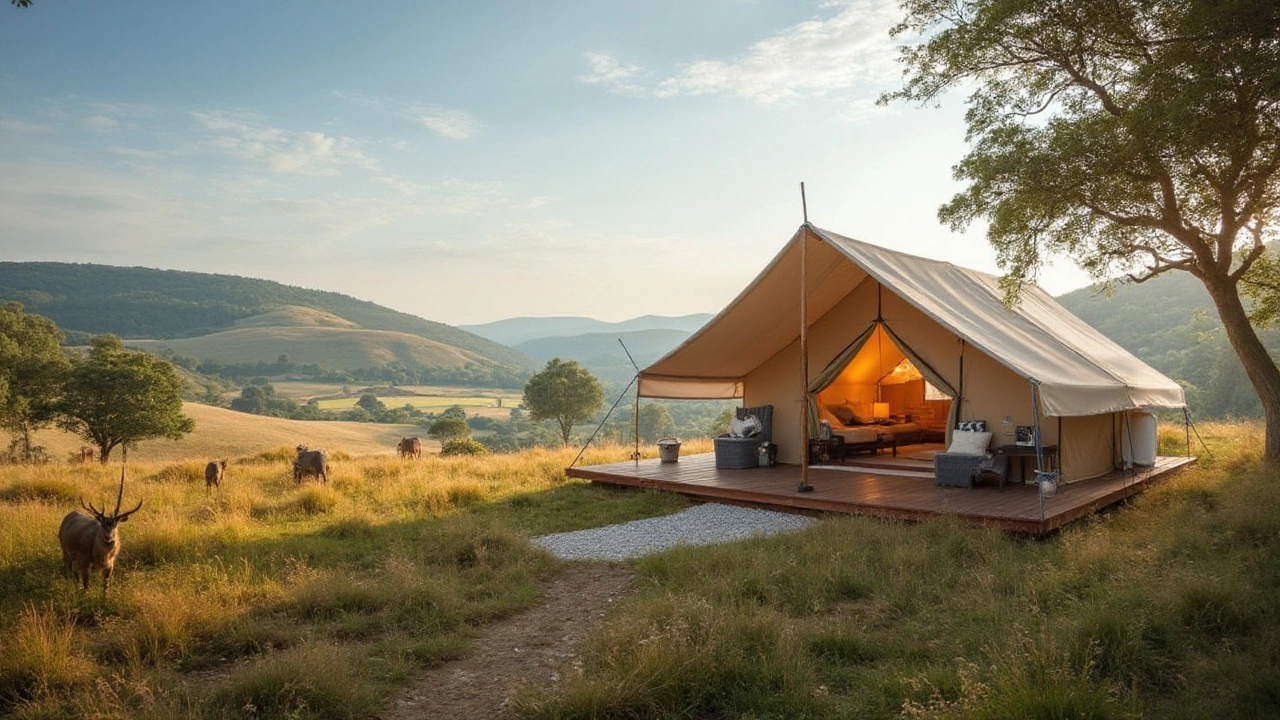Is Glamping Eco-Friendly? Exploring Sustainable Luxury Camping
26 Jan, 2025Nature curls us into its embrace, offering a serene antidote to the hustle and bustle of modern life. But what if you could savor the great outdoors without sacrificing comfort? Enter glamping – a fusion of glamour and camping that has transformed the way we experience the wilderness.
As we unravel this modern-day trend, a pressing question arises: Is this luxuriant escape kind to Mother Earth? With an increasing focus on sustainability, it's crucial to weigh glamping's ecological footprint.
This exploration will traverse the myriad ways in which glamping can be both lavish and respectful to our natural surroundings, offering insights into practices, structures, and decisions that honor the planet.
- What is Glamping?
- Understanding the Environmental Impact
- Eco-Friendly Practices in Glamping
- Types of Sustainable Glamping Structures
- Tips for Choosing Green Glamping Experiences
- The Future of Eco-Friendly Glamping
What is Glamping?
Glamping, a charming portmanteau of "glamour" and "camping," represents a movement in travel that fuses luxury and nature, allowing adventure enthusiasts to experience the great outdoors with an added layer of comfort and ease. Originating as early as the 16th century amongst royalty who embarked on excursions with lavish tents, it has now evolved into a modern phenomenon embracing the need for nature without forfeiting modern conveniences. Imagine sleeping under a vast, twinkling sky, yet enjoying the plush softness of a king-sized bed; or waking up to birdsong, yet brewing a fresh coffee under the morning sun. That’s glamping for you, and it's not just a pretty face—it offers a substantial dose of solace away from urban woes.
This modern trend draws on the timeless desire to connect with our surroundings. Unlike traditional camping which often means roughing it out, glamping caters to a more comfortable mindset, where the wilderness feels like an oasis of tranquility sans the discomfort. Providing a diverse range of settings, from quaint yurts perched in stunning valleys to treetop havens tucked amid lush canopies, glamping invites its followers to experience nature like never before. Guests can have everything from running water, electricity, and even gourmet meals prepared on-site, seamlessly blending the allure of rustic life with the utilities of home. It's a splendid concoction for nature lovers who still cherish a bit of luxury in their expeditions.
According to the Global Glamping Survey, "Nearly 60% of glampers are seeking an experience tied to wellness, often choosing locations that provide both peace and opulence." This clearly underscores the shifting preferences of modern travelers towards meaningful, rejuvenating experiences easily found in eco-friendly sites.
Glamping spots are spread across a spectrum of unique setups, offering varied interactions with nature. You can discover well-equipped safari tents nestled in national parks, lodges placed on idyllic waterfronts, or geodesic domes designed for immersive stargazing—each promising a distinct adventure. Locations often keep environmental consequences in mind, employing eco-conscious strategies like utilizing sustainable materials or solar panels, making them doubly attractive to those concerned about reducing their travel footprint.
For the digital nomads and city dwellers who yearn for a break yet disdain giving up connectivity and comfort, glamping serves as the perfect compromise. With smart designs, scenic beauty, and environmental sensitivity often taking center stage, this mode of travel embodies a balance between convenience and conservation—a narrative few other travel forms have managed to achieve. In this growing industry that not only cherishes the natural world but flaunts it, the quaint slice of escapism named glamping holds its place as a trend that is here to stay, continually evolving in its offerings to meet the varied expectations of its patrons.
Understanding the Environmental Impact
Peeling back the layers of what defines glamping brings us face-to-face with its environmental aspects. At first glance, the plush interiors and curated aesthetics of glamping sites may seem far removed from nature's rugged beauty. At the heart of the matter lies an intriguing paradox: can luxury and sustainability coexist harmoniously in the wild? To delve into this, we need to dissect both the tangible and intangible impacts on the environment. Unlike traditional camping, which often requires little more than a tent and a few essentials, glamping frequently entails the construction of semi-permanent structures that can alter the natural landscape. These structures range from yurts and treehouses to safari tents, each possessing unique environmental considerations. Material use and land clearance are significant factors here; however, many establishments are beginning to adopt innovative designs constructed from sustainable materials like bamboo and recycled wood.
Another prime consideration involves the eco-friendly practices employed by these establishments. Waste management is a critical aspect, and responsible glamping sites implement stringent recycling and composting protocols. This reduces the waste footprint, a laudable step towards mitigating adverse environmental effects. In addition, many glampsites use renewable energy sources like solar panels, which curtail reliance on fossil fuels, further enhancing their green credentials. According to a study by Green Earth, approximately 40% of new glamping sites report incorporating solar solutions to power their amenities. This burgeoning trend is paving the way for a more environmentally conscious approach to luxury camping, showcasing that glampsites can indeed prioritize sustainability without compromising on comfort.
Water usage also plays a pivotal role in the environmental impact of glamping. Efficient water systems that minimize consumption and reuse resources effectively are indispensable. Low-flow toilets, water filtration systems for natural water sources, and rainwater harvesting technologies substantiate the claims of sustainable camping practices. The innovative synergy of modern technology and traditional methods reflects a promising frontier in making glamping a truly green travel experience. Despite these advancements, it is imperative to recognize the variability among glamping sites. Quality and commitment to environmental stewardship can differ widely, thus influencing the net environmental impact. As such, discerning travelers are encouraged to seek out reputable sources and read reviews to verify if a glampsite genuinely adheres to eco-friendly principles.
Illustrating the industry's shift, Jim McAdams, an environmental scientist with decades of field experience, mentions,
"Sustainable tourism isn’t a fad. If done properly, glamping can set a new standard for traveling lightly yet luxuriously. It's about restoration, not just recreation."His insights resonate with an increasing number of eco-conscious travelers who long for the tranquility of nature while still adhering to responsible travel principles. This balance is crucial as we move forward, and the realization that our leisure activities can leave indelible marks on the environment continues to shape evolutionary practices within the glamping industry.

Eco-Friendly Practices in Glamping
Glamping, a blend of 'glamorous' and 'camping', is a stylish escape into nature without renouncing the comforts of a modern hotel. As travelers increasingly crave experiences that meld luxury with nature, there's an imperative to ensure that these escapes are environmentally sustainable. **Eco-friendly** practices in glamping can significantly minimize the ecological footprint, ensuring that while guests indulge, nature remains unscathed. These practices are not merely trendy but reflect a deeper commitment to sustainability, ensuring that guests can enjoy nature's grandeur without guilt.
One prominent practice is constructing glamping sites with sustainable materials. This involves using wood sourced from sustainably managed forests or recycled materials. Tents and lodges made from organic cotton or other eco-friendly textiles are examples of this thoughtful design. Some sites even feature roofs made from locally sourced thatch or sod, creating insulation naturally and blending harmoniously with the surroundings. By opting for such materials, glamping sites ensure they leave no long-lasting trace on the land. This attention to construction is a nod to a sustainable legacy, a lesson taught by many indigenous cultures who lived harmoniously with the earth.
Another critical aspect is energy efficiency. Modern technology offers renewable energy sources like solar panels or small wind turbines to power these sites. Glamping setups may also utilize energy-efficient appliances and LED lighting, reducing energy consumption drastically. For example, in the serenely luxurious camps of Africa where the expansive savannahs meet high-design luxuries, solar power is prevalent. This ensures that while guests revel in luxury, they tread lightly on the ecosystem.
"We all know that the only way to realize sustainable development is to do it hands-on," says Stefan Gössling, a noted sustainability researcher. This philosophy extends to the daily operational practices within glamping sites.
Water management practices are also pivotal. This may involve setting up rainwater harvesting systems to provide water for non-drinking purposes or installing graywater systems for irrigation. Low-flow plumbing fixtures ensure minimal water wastage, allowing sites to function efficiently even in arid environments. Additionally, composting toilets are becoming popular for their ability to conserve water and return organic matter to the environment as nutrient-rich compost. Camping without contaminating the pristine locales ensures a sustained visit for generations. Likewise, the tranquility of a forest or lakeside can only be fully appreciated when it remains unpolluted by human waste.
Waste management cannot be ignored in a discourse on eco-friendly glamping. Implementing robust recycling initiatives, reducing plastic use, and ensuring minimal waste production are vital. Glamping sites often follow a 'leave no trace' principle, encouraging guests to minimize their impact just as much as the site operators do. Moreover, food waste can be composted on-site, providing nutrition for kitchen gardens that often supply on-site restaurants with fresh produce. This closed-loop system not only reduces waste but also promotes sustainable dining practices. Guests are often part of this loop, encouraged to engage with the process, nurturing both their body and consciousness.
Finally, the location of glamping sites is carefully chosen to minimize impact on wildlife and promote biodiversity. By situating accommodations on already cleared lands or those areas that have been minimally disrupted, habitats remain secure for local fauna. Some glamping sites participate in conservation efforts, such as reforestation projects or wildlife protection initiatives, allowing guests to contribute meaningfully to these causes. These practices embody a holistic approach to **green travel**, ensuring guests not only rest but rejuvenate both body and earth. By partaking in such initiatives, glamping becomes more than an indulgence; it transforms into a journey back to the roots of ecological harmony.
Types of Sustainable Glamping Structures
When it comes to glamping, the choice of accommodation can make a significant impact on its eco-friendliness. From yurts to treehouses, these structures are often thoughtfully designed to blend with nature while minimizing their environmental footprint. Among the most popular options are eco-friendly yurts. Originating from Central Asia, yurts have a design that's both simple and sophisticated, with a wooden frame and fabric cover that's typically made from natural fibers. This not only allows for easy assembly and disassembly without leaving a permanent impact on the land but also provides natural insulation, keeping the interior cool in the summer and warm in the winter.
Another growing trend is sustainable treehouses. These whimsical structures not only ignite a sense of childhood wonder but are also symbols of innovation in sustainable living. Built around the trees without harming them, modern treehouses utilize renewable materials and are often powered by solar panels, making them a prime example of harmonious coexistence with nature. According to a report by the Ecotourism Society, accommodations like treehouses can reduce land usage by up to 50% compared to traditional setups, making them an attractive choice for the eco-conscious.
Geodesic domes are another fascinating option. Their convex shape lends them incredible structural strength, which means they use minimal materials while maximizing space. These domes often integrate eco-technologies such as rainwater harvesting systems and composting toilets, showcasing a commitment to sustainable practices. Inside these futuristic structures, travelers often enjoy ample natural light thanks to strategically placed windows, reducing the need for artificial lighting. A study published in the Journal of Green Building highlights that geodesic domes can reduce energy consumption by over 30% when compared to standard construction methods.
Tiny homes have also carved a niche in the glamping world. Their small footprint aligns perfectly with the ethos of green travel, using fewer resources and generating less waste. Many of these homes are built with reclaimed materials and incorporate off-grid solutions like composting toilets and solar energy. This makes them incredibly sustainable and self-sufficient, allowing adventurers to enjoy the great outdoors without compromising modern conveniences.
The Tiny Life organization notes, "Tiny homes utilize space efficiently while promoting a minimalist lifestyle, which aligns seamlessly with the principles of sustainability."
Tents, the classic symbol of camping, have also seen a sustainable makeover. Traditional tents are being replaced or retrofitted with eco-friendly fabrics, such as organic cotton, hemp, or recycled polyester. These materials possess natural breathability and strength, reducing the need for chemical treatments and extending the life of the tent. Some glamping sites now offer safari tents equipped with modern amenities while maintaining a low environmental impact. This thoughtful integration of technologies proves that even temporary shelters can be eco-conscious.
The next time you embark on a glamping adventure, consider the myriad of sustainable options available. Each offers a unique way to experience the beauty of nature without leaving a trace. Whether you're drawn to the charm of a yurt, the innovation of a treehouse, or the efficiency of a tiny home, these structures exemplify the possibilities of an eco-friendly future.

Tips for Choosing Green Glamping Experiences
Wandering amidst nature's splendor while basking in the comforts of a glamping retreat might seem like a dream come true. Yet, each choice we make echoes through our environment. How can we ensure that our glamping experience is both luxurious and respectful to the planet? Here's a guide to picking eco-friendly glamping adventures that tread lightly on Earth.
One of the first things to scrutinize is the very construction of glamping accommodations. Many sustainable camping sites incorporate renewable materials and eco-conscious designs. Inquire if their structures utilize sustainable resources like bamboo, reclaimed wood, or canvas made from recycled materials. Some glamping sites even use solar panels or offer composting toilets, minimizing their carbon footprint. A simple question can go a long way: Does the site have certifications or accolades for sustainability? Organizations such as LEED or Green Key often award those certifications only to environmentally sound establishments.
Consider the Location's Impact
Location is everything, not just in real estate but in camping as well. Examine whether the site is designed to work with the natural environment instead of against it. This might mean looking for spots that conserve the native vegetation and respect local wildlife. A strong indicator is the absence of large-scale alterations like leveling hills or cutting down trees. Meanwhile, sites that enage in reforestation or have a 'leave no trace' policy underscore a commitment to preserving the wilderness. Remember, isolation might equal beauty, but also consider the land's health and the sustainability of accessing truly remote areas. Often, the best places have balanced the scales between accessibility and conservation.
Catherine Clifford of CNBC once noted, "Sustainable tourism is not just a market trend but a requisite."
Green travel decisions often revolve around the amenities offered. Query about the energy sources – renewable energy signifies a dedication to reducing emissions. Additionally, look for glamping sites advertising environmentally-safe toiletries and, a crucial point often overlooked, locally-sourced food. Farm-to-table dining not only reduces carbon emissions due to transport but also supports the community. For those beverages and delectable meals you do savor, ask if they use biodegradable or reusable utensils. It's small steps like these, repeated often, that cumulatively shape a greener world.
Engage with Responsible Practices
Once you've set foot on your glamping paradise, what next? Seek activities that contribute to the locale you're visiting. Many top-notch eco-camps offer eco-friendly pursuits – think guided nature walks with an emphasis on education or hands-on conservation projects. The experience should be an exchange; you relax, they educate, and together, you sow back into the land. Furthermore, responsible glamping encourages minimizing waste. Think shrewdly: can you carry reusable water bottles, refuse that plastic bag for souvenirs, or truly minimize energy consumption? When sites offer recycling and waste segregation, they signal readiness to support your green intentions. An interaction with the environment is, after all, more rewarding when it's reciprocal.
To sum up, selecting a sustainable glamping adventure involves reflection and diligence. From knowing how your temporary home was built, to immersing yourself in responsible practices and insisting on various green amenities, each step grooms us into better stewards of the planet. We may discover that the most stunning accommodations harmonize with nature rather than compete with it, allowing travelers to enjoy Earth's grandeur with a heartful gratitude for its care.
The Future of Eco-Friendly Glamping
Imagine a world where you fall asleep under a canopy of stars, nestled in a luxurious tent designed with the planet’s health in mind. The future of eco-friendly glamping is quickly approaching as more travelers yearn for authentic nature experiences without a heavy ecological footprint. With technology and awareness on the rise, sustainable camping is poised to become a mainstay in the travel industry.
One fascinating development is the integration of renewable energy sources. Solar panels adorning glamping sites are no longer a rarity, but a testament to how we can comfortably coexist with nature. These panels provide clean energy for lighting and basic appliances, reducing reliance on fossil fuels and minimizing emissions. You might even encounter wind turbines quietly spinning in secluded spots, making sure that every aspect of the glamping stay is as green as possible.
Moreover, eco-conscious architects have begun embracing innovative designs that harmonize with the environment. From geodesic domes to yurts crafted from sustainable materials, the structures themselves speak of a future where sustainable camping is the norm. These designs focus on minimizing disruption to the landscape, often employing raised platforms that leave the earth beneath undisturbed, and choosing materials that blend seamlessly into their surroundings.
"Glamping can and should be aligned with nature conservation efforts," according to renowned environmentalist Rachel Carson, who said, "We must re-think our approach if we want to preserve the very essence of the experience we offer."
The hospitality industry is also getting more creative in reducing waste. Composting toilets are becoming more common, turning what used to be seen as waste into valuable resources. Add to that water recycling systems that ensure every drop is used wisely for tasks like watering surrounding vegetation, and it's clear that a glamping site can be both luxurious and sustainable.
Future innovations might also include smarter technology. Picture smart tents that adapt to weather changes or living roofs of flora that not only insulate but provide habitats for local wildlife. Some sites may soon feature interactive apps giving guests real-time updates on their environmental impact, creating a more engaging and educational experience. A greener experience doesn't mean less enjoyment; on the contrary, it can enhance the stay.
Glamping's eco-friendly evolution is not just limited to the accommodation. Locally-sourced and organic food options are increasingly part of the package, providing nourishment that's both delicious and environmentally sound. Chefs are embracing farm-to-table menus that showcase regional produce, thereby supporting local economies and reducing carbon footprints associated with transporting food.
| Feature | Eco-Friendly Benefit |
|---|---|
| Solar Panels | Provide renewable energy, reducing carbon footprint |
| Composting Toilets | Minimize water usage and turn waste into fertilizer |
| Local Produce | Reduces transportation emissions and supports local farmers |
The horizon is bright for green travel enthusiasts. Eco-friendly glamping is more than a passing trend; it's a transformative approach to experiencing the outdoors. As travelers and hosts continue to learn and innovate together, it's clear that the journey ahead is as sustainable as it is exhilarating.

 by
by